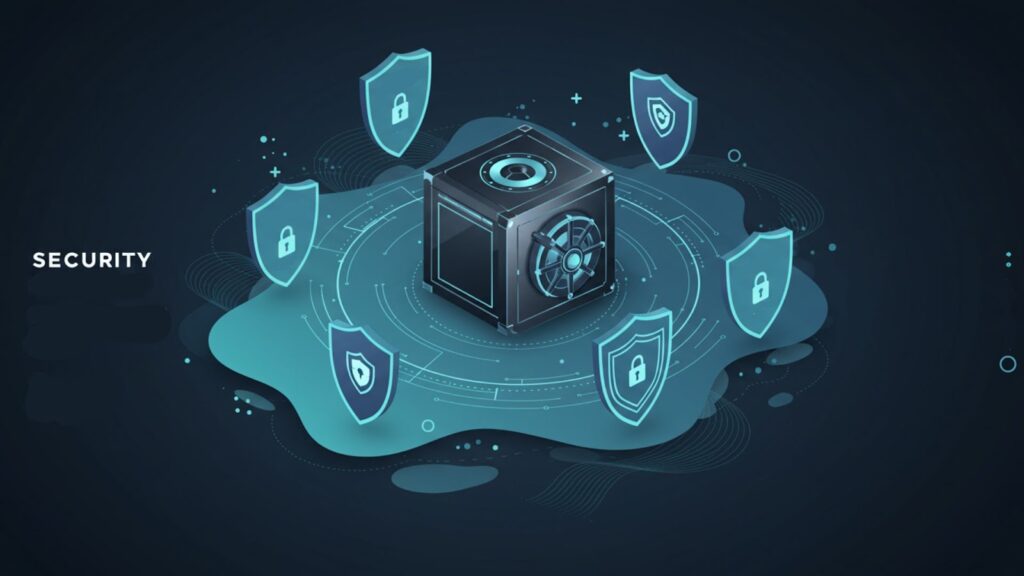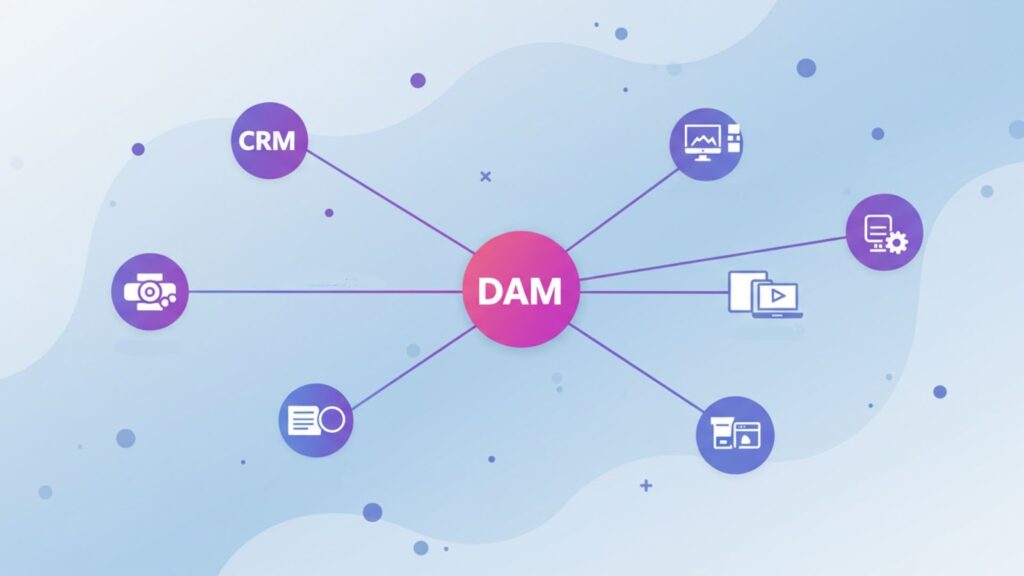Enterprise digital asset management systems require advanced capabilities beyond basic file storage.
- Scalability, security, and AI-powered automation are non-negotiable for large organizations managing millions of assets
- Feature comparison reveals significant gaps between enterprise DAM solutions and basic storage platforms
- Leading analysts recognize platforms that combine intelligent workflows with enterprise-grade governance
- ROI calculations show high returns when organizations implement comprehensive enterprise DAM systems
Choose an enterprise digital asset management system that can scale with your business while delivering measurable productivity gains.
Digital Asset Management (DAM) solutions offer benefits for businesses of all sizes. However, large enterprises have even more to gain than most. These companies have specific, demanding requirements for their DAM platform, particularly in terms of scalability, security, and technical capabilities. Not all solutions meet these requirements, which makes finding the right enterprise digital asset management system absolutely critical for success.
Large enterprises’ unique needs stem from the simple fact that they have more to manage: more people, projects, and assets. This expanded scope means their enterprise DAM software must be particularly feature rich, accommodating a wide variety of project types and user demands while remaining flexible for large teams and complex projects.
Recent market analysis shows the global DAM market is projected to reach $16.18 billion by 2032, driven largely by enterprise adoption of AI-powered content operations platforms.
What Makes an Enterprise Digital Asset Management System Different?
Enterprise DAM requirements extend beyond the capabilities of mid-market solutions or basic file storage platforms. While smaller organizations might manage thousands of assets for a single brand, enterprises typically handle hundreds of thousands of assets across multiple brands, regions, and business units.
Here’s how enterprise digital asset management systems differ:
- Scale and Performance: Enterprise systems must handle massive volumes without performance degradation, including support for unlimited users, petabyte-scale storage, and real-time processing across global teams.
- Advanced Governance: Enterprise DAM requires sophisticated approval workflows, compliance tracking, and rights management that accommodate complex organizational structures and regulatory requirements.
- Integration Depth: Rather than basic API connections, enterprise systems need deep integrations with existing martech stacks, ERP systems, and specialized industry tools.
- AI-Powered Intelligence: Modern enterprise DAM platforms leverage artificial intelligence for predictive metadata, automated workflows, and intelligent asset recommendations that dramatically improve productivity at scale.
Essential Enterprise DAM Features Comparison
| Feature Category | Basic DAM | Mid-Market DAM | Enterprise DAM |
| User Capacity | 10–50 users | 50–500 users | Unlimited users |
| Storage | 1–10 TB | 10–100 TB | Petabyte-scale |
| AI Capabilities | Basic tagging | Smart search | Predictive metadata, automated workflows |
| Security Certifications | SSL encryption | SOC 2 | GDPR, FINRA, FedRAMP, ISO 27001 |
| Integration Options | 5–10 basic APIs | 20–30 integrations | Extensive enterprise integrations |
| Workflow Automation | Basic approval | Multi-step workflows | AI-powered dynamic routing |
| Global Deployment | Single region | Multi-region | Global CDN with local compliance |
| Analytics & Reporting | Usage statistics | Performance dashboards | ROI tracking, predictive insights |
| Professional Services | Self-service setup | Guided onboarding | Dedicated success management |
7 Criteria to Help You Choose an Enterprise Digital Asset Management System
When evaluating enterprise DAM solutions, consider each option from multiple perspectives. Ask “Who will be interacting with this software?” For many large enterprises, their DAM platform will be accessed by stakeholders at multiple levels, including C-suite executives, marketers, and creatives. If external partners and clients also access the DAM, their experiences should be considered as well.
Here are the top seven criteria you need to consider when choosing an enterprise DAM system.
1. Data Security and Compliance
Cybercrime is on the rise. In the U.S. alone, it accounted for more than $12.5 billion in monetary damages in 2023. Considering this figure, enterprise-grade data encryption is a critical feature in a DAM system, especially for large businesses. In fact, it should be one of the very first things you consider when evaluating new content management solutions.

By choosing a platform that boasts best-in-class security capabilities, you can rest easy. You’ll know your data will be protected by advanced security measures, both automatic and customizable. Look for platforms with comprehensive security features:
- Industry Certifications: Your chosen enterprise DAM software should meet the strictest industry security standards, such as SOC2 Type II, GDPR, FINRA, and FedRAMP. Following these standards will help ensure your data is kept safe and is managed according to research-based best practices.
- Audit Reporting: Enterprise DAM software should support regulatory compliance by offering audit tracking capabilities as well as retaining records and reference links.
- Native CDN: This feature allows for improved network access restrictions and expiration tokens, which can help increase asset protection on a global scale.
- AI Data Security: AI integrations can come with vulnerabilities if your data is being used to train the underlying AI models. Look for platforms that don’t use your data to train public AI models.
- Data Protection and Backups: An enterprise DAM system should automate and store frequent backups to prevent data loss and have comprehensive disaster recovery plans in place.
2. Maintaining Brand Integrity
The best enterprise DAM software ensures every user can access and even create quality brand content, even those who may not have a creative background. It will foster participation in content creation while helping to monitor and control for brand integrity.
Look for software with tools that help automate content customization processes, like localization and content personalization. These tools allow a wider range of users to create basic content that meets brand standards and help free your creative experts to focus on more complex projects.
Modern enterprise digital asset management systems now include AI-powered brand governance features that automatically detect potential brand violations and trigger appropriate review workflows.
Other brand-management benefits an enterprise-level DAM solution should provide include:
- Security Features: Think beyond just data protection. To improve brand integrity, an enterprise DAM system should allow for granular permission levels, digital watermarking, and user rights tracking. These features help protect assets from misuse, both accidental and malicious.
- Easy Access to Key References: The harder it is to find the rules, the less likely they are to be followed. A great DAM solution makes resources like brand assets, guidelines, and templates quick and intuitive for users to access. Marketers and creatives can speed up the content creation process and stay consistent with the most up-to-date brand guidelines.
- Centralized Content Hub: Sales teams should be able to access, review, and deliver brand and campaign content from a centralized location with granular access permission controls and accessibility from anywhere to help avoid miscommunication and security lapses.
3. Scalability
The best enterprise DAM solutions should handle large volumes of digital assets without performance impact. Scalability for large enterprises includes:
- Multi-language Support to facilitate content localization strategies across global markets and diverse regional teams.
- Real-time Processing for efficient asset management and team collaboration across regions and time zones.
- Elastic Infrastructure that automatically scales during peak usage periods without manual intervention or additional costs.
- Robust Access Controls to ensure data security isn’t compromised with user growth, including sophisticated permission systems for complex organizational hierarchies.
4. Integration With Existing Tech Stack
An enterprise’s DAM solution should break down information silos, not build them. Coose a software platform that integrates with the tech ecosystem that you’re already using.
When looking for an enterprise digital asset management system, check whether it can work seamlessly with your existing tools and platforms, such as:
- Analytics software (Tableau, Power BI)
- Collaboration tools (Slack, Microsoft Teams)
- CRM systems (Salesforce, HubSpot)
- E-commerce platforms (Shopify, Magento)
- Design software (Adobe Creative Cloud, Canva)
- Marketing automation tools (Mailchimp, Marketo)
- Social media management systems (Hootsuite, Sprout Social)
- Content management systems (WordPress, Drupal)
- Product information management (PIM) systems
Every existing tool that you can connect with your chosen DAM platform represents time and resources saved. These integrations eliminate obstacles between migrating assets and data from one platform to another.

If your enterprise DAM solution of choice doesn’t support a specific integration that you need, check whether it has a flexible API that will let you customize the platform according to standard integration protocols such as REST or GraphQL.
5. AI and Automation Capabilities
Automation has been a feature of enterprise DAM software for a while now. However, the rise of intelligent automation capabilities has completely rewritten expectations and possibilities for DAM solutions.
With intelligent asset management, you can supercharge your automation workflows. Reduce the time and effort needed to create, manage, and distribute on-brand content. And you can better track and ensure adherence to brand guidelines.
The most advanced enterprise digital asset management systems now incorporate what’s known as “Smart DAM” capabilities: AI-powered features that transform traditional asset storage into intelligent content operations platforms.
Look for these advanced automation features in your short-listed enterprise DAM solution:
AI-Powered Metadata Creation: When you upload assets, intelligent asset management can fill out metadata fields and recommend tags for you. This is a radical timesaver, especially for teams that upload high volumes of content. Advanced systems can even be trained to automatically recognize your products or brand names.
Automated Content Creation and Transformation: Intelligent asset management makes cropping or converting files as simple as clicking a button. With generative AI capabilities, you can streamline the creation and editing of images, videos, and text for use in social media or blog posts.
Workflow Automation: Team productivity will increase by creating workflows and automation triggers for changing asset statuses and notifying reviewers to begin approval processes.
Intelligent Asset Discovery: AI-powered search functions can surface the most relevant results more quickly and accurately, saving time and reducing workday interruptions.
Automated Brand Safety and Compliance: By training models on your own data, you can identify AI-influenced content and trigger review workflows, checking for compliance with data regulations.
6. User Experience and Support
Enterprise organizations typically have diverse user bases, from highly technical developers to creative professionals and business users with limited technical experience. Your chosen enterprise DAM software must accommodate all these user types while maintaining sophisticated functionality.
Here are some questions to ask when evaluating enterprise-level DAM solutions:
- Is it easy to upload and organize assets?
- Is it easy to find and share the assets you need?
- Does the system facilitate and enhance collaboration?
- Does the system help combat information silos?
- Is the user interface visually appealing?
- Is the user interface easy to understand?
- Is the user interface enjoyable to use?
- Does the vendor have 24/7 customer support?
- Does the vendor provide a dedicated account manager for troubleshooting?
- Does the vendor offer a comprehensive onboarding process?
- Can the system be customized to meet your specific needs?
- Does the system have an active online support community?
7. Pricing and ROI
Every large enterprise has particular structures, modes of operation, and levels of DAM needs. Consequently, if a DAM software provider is charging one flat price for all its large-scale clients, that’s a red flag. There’s a strong chance that a one-size-fits-all price equates to a one-size-fits-all design, with no available system tailoring to meet your specific requirements.
A fully customizable enterprise digital asset management system should be priced according to your usage, based on metrics like:
- Number of users
- Number and type of product modules
- Number of integrations
- Data storage requirements
- Advanced AI features and automation levels
When it comes to calculating the ROI of an enterprise DAM solution, it’s important to understand the relationship between quantitative and qualitative metrics. An enterprise DAM system’s cost isn’t just about the dollars spent. The value that it will bring to your business also needs to be factored in.
Why Leading Analysts Recognize AI-Powered Enterprise DAM Solutions
Industry analysts consistently recognize the most advanced enterprise digital asset management systems for their innovative approaches to content operations. Recent analyst reports have highlighted key trends that separate market leaders from basic DAM solutions:
- AI-Driven Intelligence: Leading industry analysts have highlighted platforms that leverage AI capabilities to transform traditional DAM functionality into comprehensive content operations solutions.
- Enterprise Scalability: Top-rated platforms demonstrate the ability to handle millions of assets across global organizations while maintaining performance standards.
- Integration Ecosystem: Market leaders offer comprehensive integration capabilities that allow enterprises to build connected content operations.
- Measurable Business Impact: The highest scoring platforms provide clear analytics and ROI tracking that demonstrate tangible business value.
When evaluating enterprise DAM vendors, look for platforms that have received recognition from leading analyst firms, as this validation indicates rigorous testing against enterprise requirements.
Enterprise DAM Success Metrics and ROI
Understanding the financial impact of your enterprise digital asset management system is crucial for justifying the investment and measuring ongoing success. Enterprises typically see substantial ROI from comprehensive DAM implementations, with many organizations reporting productivity improvements and cost savings within the first 12–24 months.

Key Performance Indicators for Enterprise DAM
Productivity Metrics:
- Asset search time reduction (organizations report dramatic improvements in search efficiency)
- Content creation cycle acceleration (faster campaign delivery and production workflows)
- Duplicate asset elimination (reduced redundant content creation)
- Review and approval cycle improvements (streamlined workflow processes)
Business Impact Metrics:
- Campaign time-to-market acceleration
- Brand compliance improvement rates
- Content reuse and repurposing increases
- Agency and external production cost reductions
Technical Performance Indicators:
- System uptime and reliability metrics
- User adoption rates across different departments
- Integration success and data flow efficiency
- Security incident and compliance violation reductions
Consider a global publishing enterprise with hundreds of thousands of digital assets. The productivity cost of searching for content on an outdated platform versus implementing a streamlined, modern platform with AI-assisted automation tools needs to be balanced against the investment cost.
Consider qualitative benefits like enhancing brand reputation through higher quality, more consistent content and improving your reputation as an employer by providing superior tools that foster collaboration.
Common Challenges Enterprises Face When Implementing a DAM Solution
One more thing to consider when choosing any new software is which potential obstacles you may face during implementation. For the very last of our tips for choosing enterprise DAM software, let’s summarize some of the most common software implementation challenges. When choosing your DAM solution, look for one that addresses these upfront.
- User Resistance to Transition: Moving to any new system requires overcoming resistance from users who have adapted to existing workflows. Enterprise-level adoption requires comprehensive training and strong stakeholder involvement.
- Data and Workflow Migration: All existing digital assets, users, teams, and permissions must be transitioned without error into the new DAM solution to ensure uninterrupted productivity.
- Integration Complexity: Large enterprises have complex IT systems that need careful assessment when adopting a new solution.
- Scaling and Performance Validation: Large enterprises require new software to handle large volumes of digital assets and user traffic immediately and in real time.
- Change Management at Scale: Unlike smaller organizations, enterprises must coordinate DAM adoption across multiple departments, regions, and business units simultaneously.
The best enterprise DAM solutions will have resources for handling these challenges in addition to advanced DAM features. Look for vendors that offer dedicated implementation support and proven methodologies for enterprise-scale deployments.
Frequently Asked Questions
What’s the difference between enterprise DAM and regular DAM software? Enterprise digital asset management systems are designed for large organizations with complex requirements, including unlimited scalability, advanced security certifications, sophisticated workflow automation, and deep integration capabilities that mid-market solutions typically cannot provide.
How long does it take to implement an enterprise DAM system? Implementation timelines vary based on complexity, but typical enterprise DAM deployments take 3–6 months for full rollout across all departments and regions, with initial pilot programs often launching within 4–8 weeks.
What security certifications should an enterprise DAM have? Look for platforms with GDPR compliance, FINRA certification, FedRAMP authorization, SOC 2 Type II, and ISO 27001 certification to ensure your enterprise DAM meets the highest security and compliance standards.
Can enterprise DAM integrate with our existing martech stack? Leading enterprise DAM platforms offer 70+ pre-built integrations with major enterprise tools, including CRM, marketing automation, analytics, and creative software, plus flexible APIs for custom integrations.
What ROI can we expect from an enterprise DAM implementation? Enterprises typically see substantial returns from DAM implementations through improved productivity, reduced content creation costs, faster time-to-market, and better asset reuse across teams and campaigns.
Transform Your Enterprise Content Operations
That’s all the core criteria to consider during the selection process of a new enterprise digital asset management system. But reading through software documentation can only get you so far. It’s crucial that you and your decision team try out the DAM system to determine whether it would truly work for your organization.
The most successful enterprise DAM implementations combine advanced AI capabilities with proven enterprise-grade security and scalability. Look for platforms that have demonstrated success with organizations similar to yours in size and complexity.To see our enterprise-grade DAM solution in action and learn how leading organizations are transforming their content operations with AI-powered asset management, get in touch with our team. We’ll help you schedule your live, personalized demo and explore how Aprimo’s comprehensive platform can address your specific enterprise requirements while delivering measurable business value.


